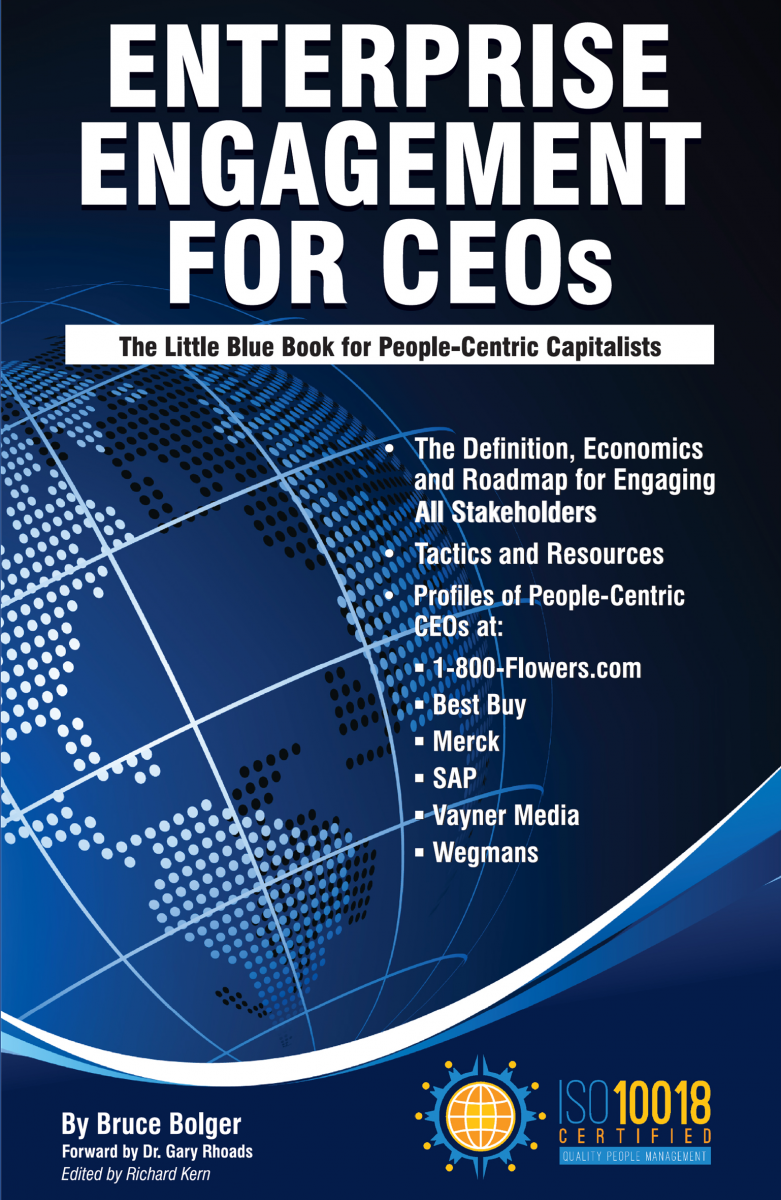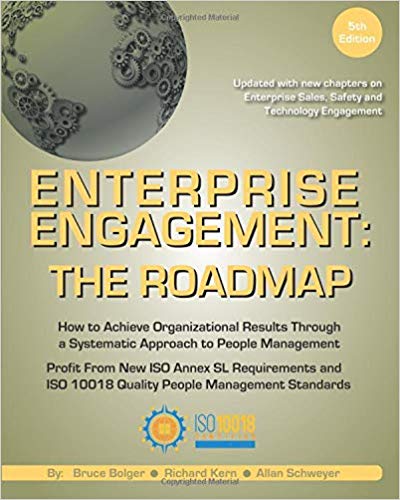As a senior HR executive with a 30-year career that spans chief human resources positions at the highest levels of the federal government and business, as well as marketing, sales, and profit-and-loss positions for a newspaper and media company, few HR leaders share Mike Anderson’s journey to and in human capital management. His key conclusions: 1) People are an organization’s most critical asset and, 2) many CEOs overlook the need for a strategic and systematic approach to management that both uplifts people and fairly distributes the wealth of the organization based on actual contributions to value created. Anderson shares with ESM what he has learned from his leadership positions.

“I believe that the key to achieving and sustaining peak performance is to uplift the human spirit.” That might be the essence of the view of this veteran human capital management executive with experience in almost all parts of business and government. Mike Anderson believes that only about 20% of CEOs and leaders understand and are truly committed to the connection between strategic people management strategies and organizational performance, whether in the private or public sector, and that the benefit of engaging employees may be overlooked in private enterprise more than in the federal government. Anderson currently provides human capital advisory services under the name of Anderson Global Talent LLC.
Engagement Processes Are Required in the Federal Government
Most people do not know that the Government Performance and Results (GPRA) Moderations Act of 2010 requires federal agencies to implement performance management systems and to strengthen employee engagement to improve organizational performance. Each year, federal departments participate in the annual Federal Employee Viewpoint Survey (FEVS) assessment, which tracks performance management and employee engagement, among other things. Each year, agencies must develop and implement a formal plan to achieve performance improvement and higher engagement. In 2012, Michael Anderson was recruited by the deputy secretary of the Department of Housing and Urban Development to turn around the sagging engagement and performance scores in the 8,000-plus person department.
“At the time, HUD had some of the worst metrics in the federal government. The solution was classic stuff. We started by learning what we were dealing with, understanding the context. Where people were. The opportunities, challenges, and what mattered most to people. These are basic leadership imperatives: understanding the landscape.
“Then, through that process, we developed a vision of where we wanted to take the agency; how to improve things. The consensus-building process happens from the very beginning. By doing a lot of listening. The vision comes from within. It forms itself from the data and information you gather. The vision takes shape by listening, learning and a professional judgement about what needs to be done.”
The Need for a Strategic Plan
That’s just the beginning, he says. “The vision must then be formulated in a written strategic plan, which then must be communicated to gain buy-in from all vested parties. Effectively selling that vision means being flexible enough to allow others to improve that vision and provide input into the strategic plan.”
“Next comes the resolve to implement. That means following through on the strategic plan’s smart goals. The alignment of the HR strategic plan with the organization’s strategic plan is very important. Everyone has to have a sense of how their work helps to accomplish the organization’s mission, as well as what’s in it for them for achieving their goals in their functional space.”
Metrics, he adds, “are critical. Everyone has to know what success looks like.” The result at HUD: “Notwithstanding pay freezes, sequestration (furloughs), and a subsequent government shutdown (a second round of furloughs), we went from the worst place to work to the most improved agency during my two years as the Chief Human Capital Officer.”
He believes it’s critical to marry employee engagement with performance improvement efforts, so that engagement efforts specifically address organizational values and priorities.
The results at HUD tagged him for an even bigger enterprise—to help improve employee engagement across the entire federal government. Described in a recent ESM article (See:
Engagement Is Critical in Government, Too, Former HUD HR Chief), Anderson was designated by the White House Office of Management and Budget to physically visit and directly engage the top 25 federal agencies to gain their buy-in to implement a government-wide strategic and systematic employee engagement plan. The strategic and systematic was summarized in a
four-page report to chief administrators could use to guide their strategic human capital plan efforts. Much of this is covered in the
ESM article. The process survived the change in administration, Anderson says, because it was influenced and owned at the non-political management level. He adds that it continues to yield annual performance and engagement survey gains because of its flexible means of adapting a systematic approach to meeting each agency’s annual goals, situation, and people.
The Power of Intrinsic Motivation
Despite the lack of stock ownership or other material incentives, profit sharing or non-cash and travel awards used in business, Anderson points out that such perks probably don’t apply to the majority of American private enterprise workers either. “What’s the biggest difference between motivation of people in business or government? Not much. Human beings are human beings. That’s the commonality whether you work for for-profit, government, or not-for-profit organizations. The principles of effective leadership are the same because you are dealing with human beings. What motivates people? Typical drivers include a sense of purpose, money, and status. At some level, money is important for us. But for many people, after a certain amount of money needed to sustain a desired lifestyle and to meet future goals, the power of money to motivate starts to diminish. The same is true with advancement and status, as they relate to motivation. For many people, whether in business, government, or non-profit sectors, the most important factor is a sense of purpose and mission. Research shows that government and non-profits rank as top places to work for many of these purpose-driven professionals. Certain areas of business (healthcare, education, staffing) also attract purpose-oriented people. Businesses can attract and retain more of these prized performers by clarifying the purpose of their companies and creating and building workplace climates that promote and nurture a sense of purpose. Millennials and Gen Z professionals are demanding purpose in their work.”
During his years at Landmark Communications in marketing, sales, public relations, HR, and managing businesses, “we were rabid about our mission at the Weather Channel, The Travel Channel, and The Virginian-Pilot, the largest newspaper in Virginia. That passion was critical to our success.” He says that organizations and brands that lose that passion will eventually see the impact on their talent and on the bottom line.
His years in business and government convinced him that intrinsic motivation is the most powerful force for sustained performance and that mobilizing people to generate profits and/or to accomplish mission. “I am a very big fan of generating profits. The question is how and whether or not those profits are equitably distributed to the people whose effort created those profits. How can you expect people to feel motivated when they know their efforts are making the top executives exceptionally rich? Today’s CEOs are taking a disproportionate share of the resources that could be used to create more wealth for everyone. The system is broken.”
The current problem with capitalism is the unfair sharing of profits, he says. “Risks are inappropriately distributed, and gains are unfairly shared. If you lead people properly, you will create more wealth. When a CEO decides to invest in people, he or she will be challenged to maximize profitability in the short term. There is tension between short-term profitability and long-term sustainability. When a company approaches business from a short-term perspective, there is an especially strong temptation to push costs and risks off on to others, including the workforce. This short-term, transactional mindset is evident and not sustainable. A better approach is one in which costs, risks, and benefits are equitably distributed based on actual contributions and the long-term sustainability of the enterprise.”
The incentives to CEOs, he notes, favor investments in short-term tactics such as stock buybacks, in squeezing costs and wages, and cutting environmental and safety corners that do not provide lasting value, and are often made at the cost of investments in people that can increase sales, retention, and reduce risks.
Profiting Through People Not From Them
“If we can get people focused on purpose, the mission, and what victory looks like for all stakeholders, we can help the human spirit flourish. That’s the approach that achieves the best result.” Note: This point of view is supported by research of the RBL Group published in ESM: So far, based on 30,000 responses from 1,200 companies, high-performing companies score particularly well on customer responsiveness, innovation, external sensing, speed and agility, and shared mindset/culture.
So will Covid-19 affect this traditional imbalance? “As human beings, we don’t change until the pain of changing is less than the pain of staying the same. Organizations can’t stay the same. That season has passed. It’s not that we didn’t understand that people were important, we just didn’t take action. The incentives are beginning to change because this new model that focuses on people makes more sense. The tide has gone out. The situation is different. The tide is coming back in. The hope is that when the tide comes back in, we will have adapted our ways to the new season.”
With a dozen years of sales, marketing, and P&L bottom-line experience, together with two decades of human capital leadership, he says, “I have seen what works. What’s different now is the evolving model for how we prosper going forward and how capitalism can better and more fairly allocate costs and risks so that it doesn’t push costs off to future years or to workers, supply chain partners, or local communities, state, and federal taxpayers through pollution or other damage to people, communities, or infrastructure.”
Anderson believes that HR has a potentially significant role to play in the coming years as organizations wake up to the importance of human capital management, measurement, and enterprise engagement. “You can’t do strategic HR without the CEO’s support. Otherwise, the strategic HR leader will not be able to do their best work. If the CEO is not demanding and supporting HR’s best efforts to make the needed changes, the effort won’t get very far.” The CEO and the entire senior leadership team must prioritize creating a climate where incentives are properly aligned to optimize human performance in the short term and the long term in order to accomplish and sustain the organization’s mission, which for businesses include generating profits and equitably sharing the wealth with stakeholders.
“It’s a governance issue,” he emphasizes. “The person who holds the purse strings has disproportionate say on how money is invested.” Changing these incentives to prosper by tapping the human spirit, he adds, “is no easy feat, as the Business Roundtable is discovering.
This Stakeholder Capitalism concept, he believes, creates a major opportunity for HR to demonstrate its value in a compelling and measurable way. “Every department head fights for resources. HR has to make the case for how it can translate its activities into the metrics the organization believes are the drivers of its success.”
He concludes, “Some organizations get it. One of the best ways to convince those that don’t is to show them the organizations that do and the results they have achieved. That’s how it works. Find people who are doing it right, and then others will learn from them when the pain of staying the same exceeds the pain of changing.”
For More Information
Mike Anderson
Mike.anderson3@gmail.com
Master the Principles of Stakeholder Capitalism And Implementation Through Enterprise Engagement
Education, Certifications, and Information to Activate
Stakeholder Capitalism Available Nowhere Else
A complete learning, certification, and information program and a course syllabus for educators.
Training and Certification
Enterprise Engagement Alliance Education: Certified Engagement Practitioner; Advanced Engaged Practitioner, and Certified Engagement Solution Provider learning and certification programs on how to implement Stakeholder Capitalism principles at the tactical level.

Join the EEA to begin your certification process or see our other resources below.
THE ONLY BOOKS ON STAKEHOLDER CAPITALISM IMPLEMENTATION

Enterprise Engagement: The Roadmap 5th Edition
The first and most comprehensive book on Enterprise Engagement and the new ISO 9001 and ISO 10018 quality people management standards. Includes 36 chapters detailing how to better integrate and align engagement efforts across the enterprise. (312 pages, $36.)
OTHER RESOURCES TO ACTUALIZE STAKEHOLDER CAPITALISM
Communities: The Enterprise Engagement Alliance and Advocate and the Brand Media Coalition free resource centers offering access to the latest research, news, and case studies; discounts, promotions, referrals, and commissions, when appropriate to third-party solution providers from participating coalition solution provider members.
Enterprise Engagement Resources: EEXAdvisors.com provides the only curated online marketplace to access hundreds of solution providers in all areas of human capital management and enterprise engagement throughout the world.
Online Overview:
10-minute short course: click here for a 10-minute introduction to Enterprise Engagement and ISO standards from the Coggno.com learning platform.
Services:
• The Engagement Agency at EngagementAgency.net, offering: complete support services for employers, solution providers, and technology firms seeking to profit from formal engagement practices for themselves or their clients, including Brand and Capability audits for solution providers to make sure their products and services are up to date.
• C-Suite Advisory Service—Education of boards, investors, and C-suite executives on the economics, framework, and implementation processes of Enterprise Engagement.
• Speakers Bureau—Select the right speaker on any aspect of engagement for your next event.
• Mergers and Acquisitions. The Engagement Agency’s Mergers and Acquisition group is aware of multiple companies seeking to purchase firms in the engagement field. Contact Michael Mazer in confidence if your company is potentially for sale at 303-320-3777.
Enterprise Engagement Benchmark Tools: The Enterprise Engagement Alliance offers three tools to help organizations profit from Engagement. Click here to access the tools.
• ROI of Engagement Calculator. Use this tool to determine the potential return-on-investment of an engagement strategy.
• EE Benchmark Indicator. Confidentially benchmark your organization’s Enterprise Engagement practices against organizations and best practices.
• Compare Your Company’s Level of Engagement. Quickly compare your organization’s level of engagement to those of others based on the same criteria as the EEA’s Engaged Company Stock Index.
• Gauge Your Personal Level of Engagement. This survey, donated by Horsepower, enables individuals to gauge their own personal levels of engagement.
For more information, contact Bruce Bolger at Bolger@TheEEA.org, 914-591-7600, ext. 230.
 “I believe that the key to achieving and sustaining peak performance is to uplift the human spirit.” That might be the essence of the view of this veteran human capital management executive with experience in almost all parts of business and government. Mike Anderson believes that only about 20% of CEOs and leaders understand and are truly committed to the connection between strategic people management strategies and organizational performance, whether in the private or public sector, and that the benefit of engaging employees may be overlooked in private enterprise more than in the federal government. Anderson currently provides human capital advisory services under the name of Anderson Global Talent LLC.
“I believe that the key to achieving and sustaining peak performance is to uplift the human spirit.” That might be the essence of the view of this veteran human capital management executive with experience in almost all parts of business and government. Mike Anderson believes that only about 20% of CEOs and leaders understand and are truly committed to the connection between strategic people management strategies and organizational performance, whether in the private or public sector, and that the benefit of engaging employees may be overlooked in private enterprise more than in the federal government. Anderson currently provides human capital advisory services under the name of Anderson Global Talent LLC. 















